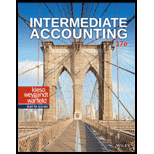
Intermediate Accounting, 17th Edition
17th Edition
ISBN: 9781119503682
Author: Donald E. Kieso, Jerry J. Weygandt, Terry D. Warfield
Publisher: WILEY
expand_more
expand_more
format_list_bulleted
Question
Chapter 16, Problem 6CA
To determine
Earnings per share: An amount available as earnings for each of the common shares outstanding for a reporting period is known as earnings per share.
To explain: To explain the reason for not including warrants in the calculation.
Expert Solution & Answer
Want to see the full answer?
Check out a sample textbook solution
Students have asked these similar questions
Please explain the correct approach for solving this general accounting question.
Accounting Question
I need assistance with this general accounting question using appropriate principles.
Chapter 16 Solutions
Intermediate Accounting, 17th Edition
Ch. 16 - Prob. 1QCh. 16 - 2. Briefly explain why corporations issue...Ch. 16 - 3. Discuss the similarities and the differences...Ch. 16 - 4. Bridgewater Corp. offered holders of its 1,000...Ch. 16 - 5. Explain how the conversion feature of...Ch. 16 - Prob. 6QCh. 16 - Prob. 7QCh. 16 - Prob. 9QCh. 16 - Prob. 10QCh. 16 - Prob. 11Q
Ch. 16 - Prob. 12QCh. 16 - Prob. 13QCh. 16 - Prob. 14QCh. 16 - Prob. 15QCh. 16 - Prob. 17QCh. 16 - Prob. 18QCh. 16 - Prob. 19QCh. 16 - Prob. 20QCh. 16 - 21. Explain how convertible securities are...Ch. 16 - Prob. 22QCh. 16 - Prob. 23QCh. 16 - Prob. 24QCh. 16 - Prob. 25QCh. 16 - Prob. 26QCh. 16 - Prob. 1BECh. 16 - Prob. 2BECh. 16 - Prob. 3BECh. 16 - Prob. 4BECh. 16 - Prob. 5BECh. 16 - Prob. 7BECh. 16 - Prob. 1ECh. 16 - Prob. 2ECh. 16 - Prob. 3ECh. 16 - Prob. 19ECh. 16 - Prob. 1PCh. 16 - Prob. 1CACh. 16 - Prob. 3CACh. 16 - Prob. 4CACh. 16 - Prob. 5CACh. 16 - Prob. 6CACh. 16 - Prob. 1CECh. 16 - Prob. 2CECh. 16 - Prob. 3CECh. 16 - Prob. 4CECh. 16 - Prob. 1CRCCh. 16 - Prob. 1ISTCh. 16 - Prob. 2ISTCh. 16 - Prob. 3ISTCh. 16 - Prob. 4ISTCh. 16 - Prob. 5ISTCh. 16 - Prob. 1ICACh. 16 - Prob. 2ICACh. 16 - Prob. 3ICACh. 16 - Prob. 4ICACh. 16 - Prob. 5ICACh. 16 - Prob. 6ICACh. 16 - Prob. 7ICACh. 16 - Prob. 8ICACh. 16 - Prob. 9ICACh. 16 - Prob. 13ICACh. 16 - Prob. 14ICA
Knowledge Booster
Learn more about
Need a deep-dive on the concept behind this application? Look no further. Learn more about this topic, accounting and related others by exploring similar questions and additional content below.Similar questions
- Can you explain this financial accounting question using accurate calculation methods?arrow_forwardCan you help me solve this financial accounting question using valid financial accounting techniques?arrow_forwardPlease provide the accurate answer to this financial accounting problem using appropriate methods.arrow_forward
- Please provide the solution to this general accounting question using proper accounting principles.arrow_forwardI need help finding the accurate solution to this general accounting problem with valid methods.arrow_forwardDetermine the price of a $1.3 million bond issue under each of the following independent assumptions: Maturity 10 years, interest paid annually, stated rate 8%, effective (market) rate 10%. Maturity 10 years, interest paid semiannually, stated rate 8%, effective (market) rate 10%. Maturity 10 years, interest paid semiannually, stated rate 10%, effective (market) rate 8%. Maturity 20 years, interest paid semiannually, stated rate 10%, effective (market) rate 8%. Maturity 20 years, interest paid semiannually, stated rate 10%, effective (market) rate 10%.arrow_forward
- If total assets increase while liabilities remain unchanged, equity must: A) IncreaseB) DecreaseC) Remain the sameD) Be negativearrow_forwardNo chatgpt!! Which of the following is an intangible asset? A) InventoryB) CopyrightC) EquipmentD) Accounts Receivablearrow_forwardWhich of the following is an intangible asset? A) InventoryB) CopyrightC) EquipmentD) Accounts Receivableno aiarrow_forward
- Which of the following is an intangible asset? A) InventoryB) CopyrightC) EquipmentD) Accounts Receivablearrow_forwardWhat does a ledger account represent? A) A detailed record of all business transactionsB) A summary of trial balancesC) An individual record for each accountD) The final balance of a financial statement Need help!arrow_forwardWhat is the primary purpose of accounting? A) To generate tax revenueB) To record, summarize, and report financial transactionsC) To determine the market value of assetsD) To manage payrollarrow_forward
arrow_back_ios
SEE MORE QUESTIONS
arrow_forward_ios
Recommended textbooks for you

 AccountingAccountingISBN:9781337272094Author:WARREN, Carl S., Reeve, James M., Duchac, Jonathan E.Publisher:Cengage Learning,
AccountingAccountingISBN:9781337272094Author:WARREN, Carl S., Reeve, James M., Duchac, Jonathan E.Publisher:Cengage Learning, Accounting Information SystemsAccountingISBN:9781337619202Author:Hall, James A.Publisher:Cengage Learning,
Accounting Information SystemsAccountingISBN:9781337619202Author:Hall, James A.Publisher:Cengage Learning, Horngren's Cost Accounting: A Managerial Emphasis...AccountingISBN:9780134475585Author:Srikant M. Datar, Madhav V. RajanPublisher:PEARSON
Horngren's Cost Accounting: A Managerial Emphasis...AccountingISBN:9780134475585Author:Srikant M. Datar, Madhav V. RajanPublisher:PEARSON Intermediate AccountingAccountingISBN:9781259722660Author:J. David Spiceland, Mark W. Nelson, Wayne M ThomasPublisher:McGraw-Hill Education
Intermediate AccountingAccountingISBN:9781259722660Author:J. David Spiceland, Mark W. Nelson, Wayne M ThomasPublisher:McGraw-Hill Education Financial and Managerial AccountingAccountingISBN:9781259726705Author:John J Wild, Ken W. Shaw, Barbara Chiappetta Fundamental Accounting PrinciplesPublisher:McGraw-Hill Education
Financial and Managerial AccountingAccountingISBN:9781259726705Author:John J Wild, Ken W. Shaw, Barbara Chiappetta Fundamental Accounting PrinciplesPublisher:McGraw-Hill Education


Accounting
Accounting
ISBN:9781337272094
Author:WARREN, Carl S., Reeve, James M., Duchac, Jonathan E.
Publisher:Cengage Learning,

Accounting Information Systems
Accounting
ISBN:9781337619202
Author:Hall, James A.
Publisher:Cengage Learning,

Horngren's Cost Accounting: A Managerial Emphasis...
Accounting
ISBN:9780134475585
Author:Srikant M. Datar, Madhav V. Rajan
Publisher:PEARSON

Intermediate Accounting
Accounting
ISBN:9781259722660
Author:J. David Spiceland, Mark W. Nelson, Wayne M Thomas
Publisher:McGraw-Hill Education

Financial and Managerial Accounting
Accounting
ISBN:9781259726705
Author:John J Wild, Ken W. Shaw, Barbara Chiappetta Fundamental Accounting Principles
Publisher:McGraw-Hill Education
Earnings per share (EPS), basic and diluted; Author: Bionic Turtle;https://www.youtube.com/watch?v=i2IJTpvZmH4;License: Standard Youtube License